




By Moyo Lawuyi
The Canadian Union of Postal Workers (CUPW) began a nationwide strike on Sept. 25, raising concerns among Toronto Metropolitan University (TMU) students who depend on their services.
The strike comes after Joël Lightbound, Minister of Government Transformation, announced new regulations for Canada Post aimed at making the delivery service more “financially sustainable,” including ending home mail delivery, which the corporation accepted but the union rejected.
“In response to the Government’s attack on our postal service and workers, effective immediately, all CUPW members at Canada Post are on a nation-wide strike,” read a statement from the national president of CUPW, Jan Simpson.
Mail and parcels will no longer be processed or delivered during the shutdown, and new items will not be accepted while the strike is in progress.
As of Oct. 6, the strike remains ongoing with no expected end date.
Third-year film studies student Kendra Kelly-Peterkin, creates user-generated content (UGC) such as clothing reviews. The strike has affected their ability to receive packages from brands in the U.S.
“That’s basically a job for me, like an-
other job for me is just making content for these brands,” said Kelly-Peterkin. “And it’s also really hard to source UGC work with Canadian brands, because a lot of them don’t compensate.”
They were also affected by the first strike, which began in November 2024, and said the postal shutdowns are pushing them to rely less on the U.S., despite it being a huge market.
Despite their source of income being affected by the strike, Kelly-Peterkin still believes Canada Post and the federal government need to treat workers better.
“I think that they need to do a better job at providing [CUPW members] what they need, especially if it’s the second time that they’re striking,” they said.
On Oct. 3, Canada Post presented a new offer to the union, which includes compounded wage increases of 13.59 per cent over four years, up to seven weeks’ vacation and preretirement leave.
“Canada Post’s new offers are within the limit of what the Corporation can afford while maintaining good jobs and benefits for employees over the long-term,” said the corporation in a news release.
However, the union rejected the bargain, saying the offers were worse than what they rejected in August.
Shalom Ologun, a third-year nursing student at TMU owns a small business that

TMU gathers to commemorate ‘Ozaawaa Babigoyaan Giizhigad’
The day is also known as National Day for Truth and Reconciliation and Orange Shirt Day
By Shaaranki Kulenthirarasa
Students, staff and faculty members at Toronto Metropolitan University (TMU) gathered at the Sheldon & Tracy Levy Student Learning Centre (SLC) to commemorate Ozaawaa Babigoyaan Giizhigad, also known as Orange Shirt Day on Sept. 30. The day started off with an opening speech and various presentations by Indigenous speakers, including Crystal Osawamick, manager of Indigenous Events and Special Projects. Attendees also took part in an Indigenous feast and a craft-making session, where they made mini orange shirt flags.
Bianca Alonzo, third-year child and youth care student at TMU believes this was an important event to hold at the university, especially due to the history of the university’s name.
“I think it’s important to realize the history of it and this is a step in moving forward in

provides professional nail services to customers, particularly students. She says the strike has caused delays with products she orders for her business.
While she can shop for her products in person, she says this would be a waste of money, as she has already purchased them online, can’t get a refund and can’t receive her items because of the strike.
“This is my only job, so it’s kind of affecting my stable pay that I should be getting,” said Ologun.
According to a news release by Canada Post, all packages in the postal network will be secured and delivered as quickly as possible once operations resume. However, processing and delivery may take some time to return to normal.
Sophia Gonzales-Matte, a second-year photography student, was affected by the strikes last year.
While she understands that TMU cannot do much, she says she wishes the university could do more to make students aware of the situation.
“I feel like a lot of people don’t know that it’s happening until their package isn’t getting delivered,” she said.
In a notice issued on Sept. 26, the university confirmed that Shipping and Receiving services at TMU will continue to send and receive mail on the school’s behalf.
Financial services will also continue to print cheques, but they will not be delivered until the strike ends.
Doug Ford’s government says they’re “supporting” children and students through Bill 33.
An attack on YOUR students’ unions, student-run services, student jobs, and your campus
A dangerous precedent for exclusionary education policies, targeting marginalized students
An overreach by the government to curb academic freedoms
decolonization and I think it’s important for students to recognize that,” she said.
Nellani Jeyaseelan, another third-year child and youth care student at TMU said she returned to the event this year to show her support for the Indigenous community after attending the event with one of her classes last year. She said that as a Tamil student, it was important for her to educate herself on Indigenous culture.
“Maveerar Naal [Tamil Genocide Remembrance Day] is very important to me so I think that this is important for the Indigenous [communities]...it’s a way of me supporting them just as they would be supporting us,” she said.
Later in the day, attendees also took part in a silent memorial walk from Jorgenson hall to Kerr Quad, and watched a live broadcast of a 90-minute commemorative gathering called Remembering the Children: National Day for Truth and Reconciliation from Parliament Hill in Ottawa.
An increase in policing and surveillance
A distraction from the underfunding of our colleges and universities Doug Ford’s government does not care about students, workers, or families...
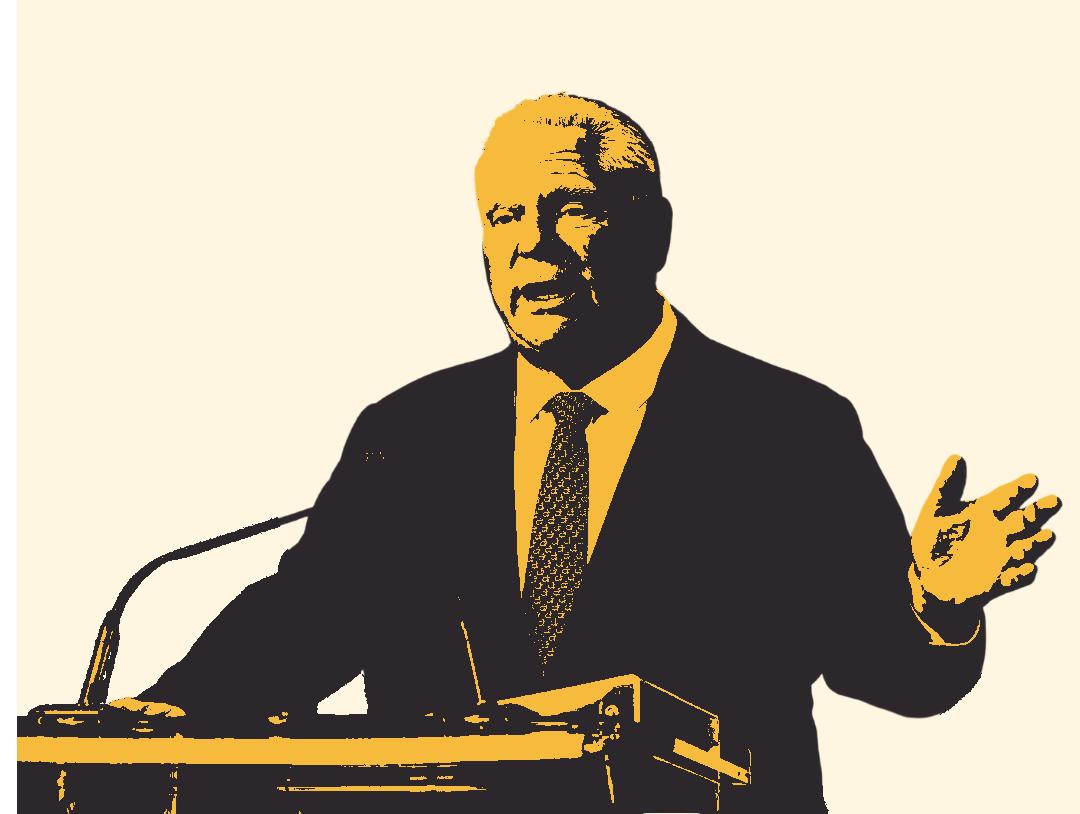
By Jerry Zhang
Thousands of pro-Palestine activists and students from all over the Greater Toronto Area gathered in downtown Toronto on Oct. 4 to mark two years since the start of Israel’s disproportionate attack on Gaza.
The protest was organized by the Palestinian Youth Movement (PYM) and various student groups, including Toronto Metropolitan University’s (TMU) Students for Justice in Palestine (SJP), according to a post on PYM’s Instagram account.
In January 2024, the International Court of Justice issued provisional measures regarding Gaza, finding that Israel’s action amounts to genocide and ordered Israel to take “immediate and effective measures” to protect Palestinians in Gaza. Last month, the United Nations declared the same. Israel’s actions are in retaliation for an attack from Hamas which killed 1,195 Israelis on Oct. 7, 2023.
At approximately 1:30 p.m., a student contingent consisting of TMU students gathered near Lake Devo.
Soon after, chants began echoing across the TMU campus as students started demanding an end to the suffering of Palestinians and divestment of TMU from companies complicit in the genocide in Gaza.
In an email statement to The Eyeopener in August, TMU said “the university does not directly invest in any companies and there is no exposure in the University’s endowment fund to companies contained in the Office of the United Nations High Commissioner for Human Rights database.”
By 2 p.m., the student contingent moved towards the larger contingent at Sankofa Square, which was packed with tens of thousands.
“We have been out in the streets for two years now”
By 2:30 p.m., the large crowd consolidated in the square around a truck that was adorned with the Palestinian flag and the images of journalists who had been killed by Israel during the ongoing genocide in Gaza. The crowd stretching five to six blocks started moving east on Dundas Street before turning north on Bay Street.
As of Oct.7, the documented death toll in Gaza for the past two years, has risen to 67,173 according to Al Jazeera with the estimated death toll being much higher.
Nearly 300 journalists have also been killed since Oct. 7, 2023, according Al Jazeera’s estimate as of Sept. 1.
Yara Shoufani, an organizer with PYM, said the march symbolized
both remembrance and resistance against the ongoing genocide.
“When the genocide happened, I felt so hopeless”
“We have been out in the streets for two years now, demanding that the Canadian government take more concrete action to stop this genocide,” she said. “Canada’s role in either selling or purchasing weapons from Israel makes Canada complicit in genocide.”
One of the organizers* of the student contingent and a member of SJP at TMU described the protest day as emotional and exhausting but necessary.
“As a Palestinian, this commemorates...beyond the two years of the genocide but it also represents the last 77 years of apartheid,” they said.
They also told The Eye about feelings of hopelessness they often experience, watching the genocide unfold in Palestine.
“We’re gonna do as much as we can”
“When the genocide happened I felt so hopeless because [it is] truly a unique experience and what it’s like to be living while your people are being genocided,” they said.
They also said that institutions like the university and the Canadian government have been turning a
“blind eye” to the genocide.
“They know what’s going on but they chose that. They chose money over people,” they said.
In July 2024, a report by Arms Embargo Now uncovered data that suggests arms are still flowing from Canada to Israel. The report found entries in the database of the Israel Tax Authority which showed Canadian-made military weapons and ammunition entering Israel.
Despite the lack of response from the Canadian government and TMU, they remain hopeful, pointing to the progress and achievements pro-Palestine activism has accomplished over the years.
“We’re gonna do as much as we can. Right now, we’re successful in that…and we’re trying to get the administration to show that even after years of you guys ignoring us…we’re gonna call you guys out,” they said.
Following the unveiling of U.S. President Donald Trump’s 20-point peace plan on Oct. 2, they expressed that they remain skeptical about the effectiveness or longevity of the deal.
As of Oct. 6, Al Jazeera has reported that 104 Palestinians have been killed despite the demand from Trump to stop Israeli attacks.
*This source has requested to remain anonymous due to the sensitivity of the matter. The Eye has verified this source.
The lawsuit seeks damages of up to $10 million in total
By Vihaan Bhatnagar and Shumaila Mubarak
Current and former students at the Lincoln Alexander School of Law (LASL) at Toronto Metropolitan University (TMU) filed a lawsuit against the university for defamation on Friday.
The statement of claim alleges damages of up to $10 million on the basis of “defamation, negligent misrepresentation, breach of contract, discrimination, and unfair practices.”
This comes two years after the students faced backlash from TMU for participating in an open letter in October 2023 expressing their “unequivocal support” for Palestine.
The open letter—dated Oct. 20, 2023—condemned Israel’s occupation of Palestine and called Hamas’ attack on Oct. 7, 2023 a “direct result of Israel’s 75-year-long systemic campaign to eradicate Palestinians.” The letter also demanded
a ceasefire, humanitarian aid to Gaza, a Canadian arms embargo on Israel and economic sanctions against Israel.
By Oct. 22, 2023, the letter and the students who signed it had started receiving “intense and widespread backlash,” according to the statement of claim.
In September, the National Post reported that a law professor lost a “bid to quash TMU’s decision not to discipline students who signed ‘antisemitic’ letter.’”
In October 2024, a United Nations (UN) commission said Israel has been illegally occupying Palestine under international law. The UN has since formally recognized that Israel has been committing genocide in Gaza since 2023.
The LASL released a public statement on Oct. 23, 2023 where they condemned “the sentiments of antisemitism and intolerance expressed” in the letter. Following the release of the open letter, a group of Jewish students at
TMU sued the university for $15 million for allegedly fostering an antisemetic environment on campus, as previously reported by The Eyeopener TMU appointed retired chief justice of Nova Scotia, J. Michael MacDonald in November 2023 to conduct an external review of “any TMU student who participated in the open letter.” The review concluded in May 2024 that the signatories to the letter did not violate the Student Code of Conduct and the claims of antisemitism were not substantiated.
“The students’ participation in the letter, when placed in its appropriate context, was nonetheless a valid exercise of student expression and therefore protected under the University’s Statement on Freedom of Speech,” MacDonald wrote in the external review.
The statement by LASL is not available online anymore. The webpage now redirects to the report by MacDonald.
The Eyeopener Masthead

Editor-in-Chief
Negin “Joojeh” Khodayari
News Editors
Shumaila “One” Mubarak
Vihaan “Down” Bhatnagar
Arts & Culture Editor
Lama “Exam” Alshami
Business & Technology Editor
Jerry “Finally” Zhang
Communities Editor
Daniel “Qualms” Opasinis
Features Editor
Edward “Clash” Lander
Fun & Satire Editor
Dylan “Snoop” Marks
Sports Editors
Jonathan “Beyond” Reynoso
Victoria “The Bold” Cha
Production Editors
Jasmine “Nemakar” Makar
Sarah “Less Wise” Grishpul
Photo Editors
Ava “ZONed Out” Whelpley
Rachel “Vocal Rest” Cheng
Pierre-Philipe “Bonne Nuit” Wanya-Tambwe
Media Editors
Divine “Crashed Out” Amayo
Lucas “Bright Rice” Bustinski
Digital Producer
Anthony “3D” Lippa-Hardy
Circulation Manager
Sherwin “Koobideh” Karimpoor
General Manager
Liane “Bike Owee” McLarty
Design Director
Vanessa “I Will Survive” Kauk
Contributors
The statement of claim alleges that the LASL response to the letter was defamatory and would “harm the Plaintiffs’ reputation in the eyes of a reasonable person.”
The statement also alleges TMU’s conduct in the matter violated sections 1, 3, 9 and 11 of the Ontario Human Rights Code. It alleges “creation of a poisoned environment at LASL” and “a failure to adequately protect them against threats made by members of the public and legal profession.”
Several of the signatories say they lost career opportunities and suffered damage to personal relationships, according to the statement of claim.
In an email to The Eye, the university said they cannot comment on legal matters.
This is a developing story and will be updated as more details become available
Tristan “Screamy” Forde
Kaitlin “Fab” Pao
Rogene “Long haul” Teodoro
Shaaranki “Sources” Kulenthirarasa
Moyo “Is or Isn’t??” Lawuyi
Myrtle “500+ Connections” Manicad
Rustin “Eternal” Peace
Sadie “Brainstorming” Sawatzky
Lia “ET” Pulumbarit
Trinity “Poser” Lee
Gray “Gray-dient” Moloy
Evan “Peter Porker” Perry
Ysmael “Take Off” Mendoza
Tejas “On Strike” Sharma
Allyson “So Punk!” Casquejo
Mohammad “Next Top Model” Abu-Shanab
Avari “Hell Fiya” Nwaesei
Eunice “Dab” Soriano
Aditi “RTA” Roy
Jocelyn “Glasses” Reycraft
Piss “Dylan” Boy
Dax “RIP” Plex
Address
55 Gould Street,
TMU students share their thoughts about being watched on campus
By Kaitlin Pao
In a world of facial recognition, website cookies and ads that hit slightly too close to home, where do Toronto Metropolitan University (TMU) students draw the line when it comes to their own school watching them?
During the 2025 Toronto Metropolitan Students’ Union (TMSU) election, it became known that OneCard taps can be monitored by campus officials. Then-chief returning officer Tatiana Carrion alleged a running candidate distributed unapproved and defamatory posters of another slate throughout Kerr Hall, claiming OneCard data showed the member entering the building at the time of the posting, as previously reported by The Eyeopener
Walking through campus, it’s hard not to notice just how many cameras are watching from above. For some students, the presence of cameras feels less protective and more disturbing.
Sebastian Johnston, a third-year film student, said being watched on campus is “unnerving.”
“Just even at this moment, while I’m chilling at the quad, how obvious the emergency camera is right there, that’s probably looking at me. I think I don’t notice it that often, but when I do,” he said.
Johnston thinks while some surveillance is useful for security, excessive tracking—such as monitoring OneCard usage—is unnecessary and intrusive. He feels security footage should be deleted promptly and that student privacy should be respected unless there’s an incident.
For first-year business management student, Julia Pralat, surveillance on campus feels like a necessity.
“Especially because we’re on a downtown campus, it’s kind of open to a lot of people. I think that it definitely does make me feel safer,” she said. “I would rather have that security than know that anybody could enter [school buildings] and things aren’t checked out.”
First-year fashion student Teela Rodney-Greenidge said that if cameras were intentionally facing bathrooms or athletic facilities, then that would be a larger concern than watching students’ daily activities on campus.
“I feel like [surveillance] doesn’t really change the way I act because it’s school. I feel like everyone that goes to school is just like, normal,” she said.
The Eye reached out to TMU for comment on their use of facial recognition and OneCard tracking technologies, but did not receive a response in time for publication.
Read more at theeyeopener.com
Punk, goth or emo, TMU’s alternative students find their moral compass in their cultures
By Tristan Forde
As students settle back into school life, they begin to search for groups that they can connect with to form new friendships and bonds.
While in search of a space for alternative students at Toronto Metropolitan University (TMU), second-year criminology student Virina Youssef found a gap for her community on campus.
“I was just thinking the best thing I could do is build community and what better way then to start a club,” said Youssef.
She took it upon herself to organize the TMU Goth Students Union (TMU Goths). The group quickly picked up traction—among not only goth students but many other alternative students.
The group had planned for its first official event—a picnic on Sept. 24 in the Kerr Hall Quad—which never happened. The event would’ve fallen on the same day as a rally in the quad, protesting the arrest of a student by TMU Security the week before.
Second-year media production student Allyson Casquejo was the first member of TMU Goths’ executive team to bring up the overlap between the picnic and the rally. “As people in the goth, alternative, punk subculture…it’s important to participate in those [types of] protests if you can,” she said.
Many members of the club planned to attend the rally in support of the arrested victim, leading to their decision to postpone the picnic, Casquejo said.
On Sept. 19, a pro-Palestinian demonstration took place during a panel hosted by The Dais featuring Canadian minister of artificial intelligence and digital innovation, Evan Solomon.
Student activists questioned the minister in protest of the involvement of digital tools in the genocide in Gaza.
The demonstrators were escorted out—and shortly after—a security guard physically restrained a student, detaining her for over an hour in a campus building at 111 Bond St, as previously reported by The Eyeopener
“I think that it is very important that if you are in any of these [alternative] subcultures, you need to rep the politics as well,” said Youssef.
“There is an ongoing genocide, it feels unfair to not highlight those things...”
Second-year psychology student Kayla Karlsson spent much of her life in online spaces enjoying media like anime and video games. She ultimately ended up on the path of alternative culture.
“A lot of alternative music is sort of about being different and as a kid who was really weird I think that really connected with me,” Karlsson said. “One of the
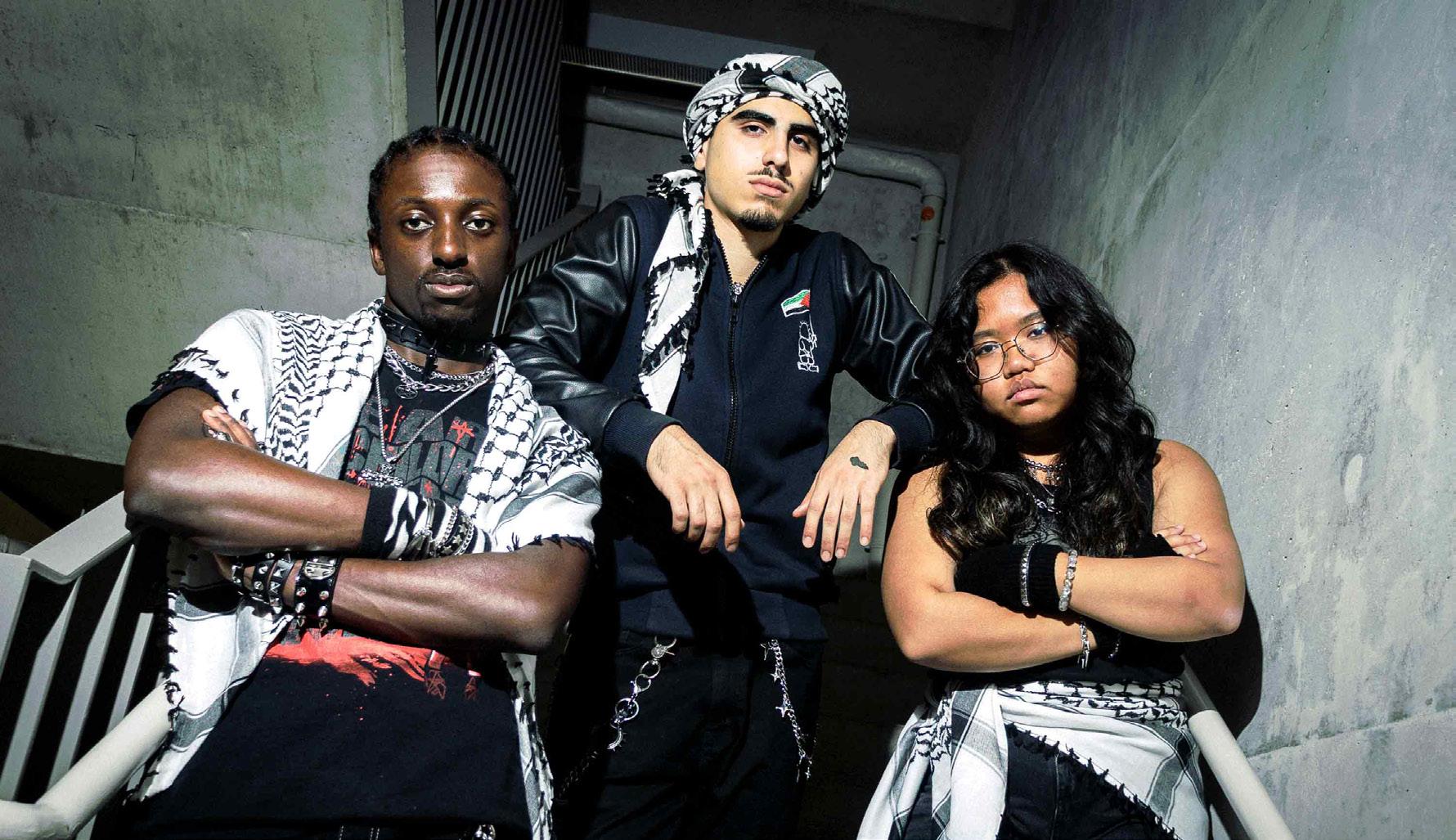
scariest things you can do is be authentic and be yourself.”
As the alternative scene began to grow more, the mid-1970s saw the rise of a much more aggressive style of rock music. Adopting the prison slang term ‘punk,’ this style of music became characterized by rebellion.
“Punk is freedom, it means freedom of speech [and] freedom of expression”
Guitarist of The Black Halos, Jay Millette said punks disliked the establishment at the time. “They were angry and they put [their disapproval] into short blasts in songs to inspire.”
Bands like the Stooges, The Ramones, MC5, the Sex Pistols and many others formed the foundation for ‘post-colonial punk,’ never shying away from addressing issues such as abortion, anti-monarchy, anti-consumerism and more, according to the State University of New York Press
As an icon of the industry, Poly Styrene of the band X-Ray Specx—a biracial woman in a predominantly white, male industry—became a beacon of hope for not only people of colour but alternative women broadly, an article in The New York Times reads.
Styrene’s legacy impacted many, as she wasn’t your “typical” punk. She leaned into the do-it-yourself (DIY) aspect of punk music by incorporating elements of pop and folk music into her songs, eventually being known as a post-punk visionary, the article continues.
The roots of punk and alternative subcultures continue to change, not going unnoticed by students on campus.
“Its nice to see that there has been a shift and there is more inclusion in that scene,” Karlsson said. “It definitely started off very [white, male centred].”
As the years went on, alternative music never stayed stagnant. Alongside post-punk music it started branching out into many different subcultures.
Goth music—emerging from
the British post-punk scene in the early 1980s—was pioneered by groups like Siouxsie and the Banshees and Bauhaus.
Emotional hardcore music, commonly known as “emo,” was spearheaded by bands like Rites of Spring and Dag Nasty, known for their raw, confessional messaging.
“Punk is freedom, it means freedom of speech [and] freedom of expression,” said Youssef.
One emerging alternative genre is Taqwacore—a blend between muslim culture and punk anti-status-quo ideology.
Bands like The Kominas and Al-Thawra challenge societal and cultural norms through a Middle Eastern lens.
A British TV show all about Taqwacore was released in 2021 called We Are Lady Parts. The show tackled the struggles women face in rock music but also highlighted the racial challenges faced by muslim women of colour in a heavily westernized society.
Much of the Taqwacore scene in recent years has been focused on standing in solidarity with Palestine amidst the genocide in Gaza. They’ve also focused on denouncing U.S. foreign policy such as their ongoing military presence in the Middle East and across Central Asia.
“Art is political, every form of art is political, even if it doesn’t seem like it is”
As more eyes turn to focus on the genocide in Gaza, countless bands and groups in the alternative scene have been using their platforms to call out corporations for their investments.
“It seems, so quickly, we’re repeating history and people are losing their rights,” said Karlsson.
Singer and songwriter Patti Smith has been proactive in signing letters of boycott, creating songs like “People Have The Power” which have been heard playing at various different demonstrations and headlining events like “Hoping
For Palestine,” in 2018.
“There is an ongoing genocide, it feels unfair to not highlight those things in music, books, art and fashion,” said Karlsson.
“If you are in any of these [alternative] subcultures you need to rep the politics as well”
Groups like Bikini Kill have hosted benefit shows with the Palestine Children’s Relief Fund and partnered with Palestinian Feminist Collective. Green Day altered their lyrics to “Jesus of Suburbia” at Coachella 2025 to address the children in Palestine. A handful of other bands have also been vocal, like Amyl and the Sniffers, Soul Glo and Against Me!
“Music has always been political and it always will be,” said Karlsson. “It’s such a great vehicle and tool to be able to express things.”
Having spent time in various alternative online spaces, Casquejo expressed frustration at those who believe subcultures and politics should remain separate.
“Art is political, every form of art is political, even if it doesn’t seem like it is,” said Casquejo.
Following recent events on TMU’s campus, the call for freedom of expression is growing.
Karlsson said TMU Security’s use of unreasonable force against a student is alarming. “It’s embarrassing,” she said.
As previously reported by The Eye, a spokesperson for the university said the school has “been made aware of the incident, and understands the concerns that have been raised. We will be reviewing this matter thoroughly and will take any necessary actions.”
Inspired by the impact music has had on politics in the past, groups like TMU Goths allow students to find like-minded individuals.
“Be an active member [of your community]. Whether you’re in a club, going to shows or at university, take advantage of that,” Youssef said. “[Don’t] be standing on the sidelines.”
By Tristan Forde
When the doors to Transmission Studios in downtown Toronto opened, attendees were presented with a lineup of paintings from various artists. That night, the versatile space had been transformed into a curated art exhibit and runway show by Toronto Metropolitan University (TMU) fashion design alumnus, Adriana Elcena with the name ‘Drift & Depart - A Museum of Escapism.’ Upbeat music filled the room as DJ Prvphet Zay controlled the speakers.
This was Elcena’s second-ever fashion show but her first one outside the confines of TMU.
She made her fashion design debut during her final year at TMU with the school of fashion’s annual Mass Exodus showcase.
She designed “The Caribbean Renaissance,” a line of clothing inspired by the Harlem Renaissance, intertwined with Jamaican and Vincentian heritage.
This time around, Elcena took inspiration from a painting she made. She blended her Caribbean heritage with themes of 1960s flight attendants—with crochet embellishments to the articles of clothing.
“I came from a space of wanting to go into a new season and a new part of my life,” said Elcena. “I knew when people want to es-
cape, some people want to go on a flight or go on a plane.”
She said she went through the process of elimination with around 100 sketches and went straight into the production process without outsourcing anything.
Elcena reached out to her fashion industry network to seek support for her exhibit.
Among them was second-year TMU fashion communication student Candice Bonair, who she met at The Remix Project—a professional arts training program for creatives in the city that she is currently involved in. Bonair was the public relations coordinator for the event, managing and organizing operations, conducting social media marketing and overseeing media and sponsorship outreach.
Alongside Bonair, a plethora of other colleagues, alumni and friends came together to support Elcena. Quite a few of the models had previously met or worked with Elcena .
Classmates and friends aside, she also received the full support of her family during her journey as a designer. Along with watching the show, her entire family were busy helping keep things organized during the event.
Elcena’s mother, Teshia Cadogan said, “She has always wanted to be a designer and this is not an easy field. It’s very competitive but she’s set
the age of streaming
By Sadie Sawatzky
As the warmer weather comes to an end and patios start to empty out, some Toronto Metropolitan University (TMU) students still have one topic from last season on their minds: the song of the summer.
In today’s shifting music landscape, the idea of a distinct song representing the summer means different things to different people, with the concept changing over time.
Salman Rana, assistant professor in creative industries and professional music at TMU, explained that the song of the summer “was always a song that was ubiquitous, that you heard everywhere.”
With the rise of the internet, the phrase has been increasingly pushed on audiences through marketing campaigns and social media. Smaller artists now pitch their tracks on TikTok, hoping to claim the title.
Megan Martin, a second-year professional music student at TMU, said, “I feel like deter -
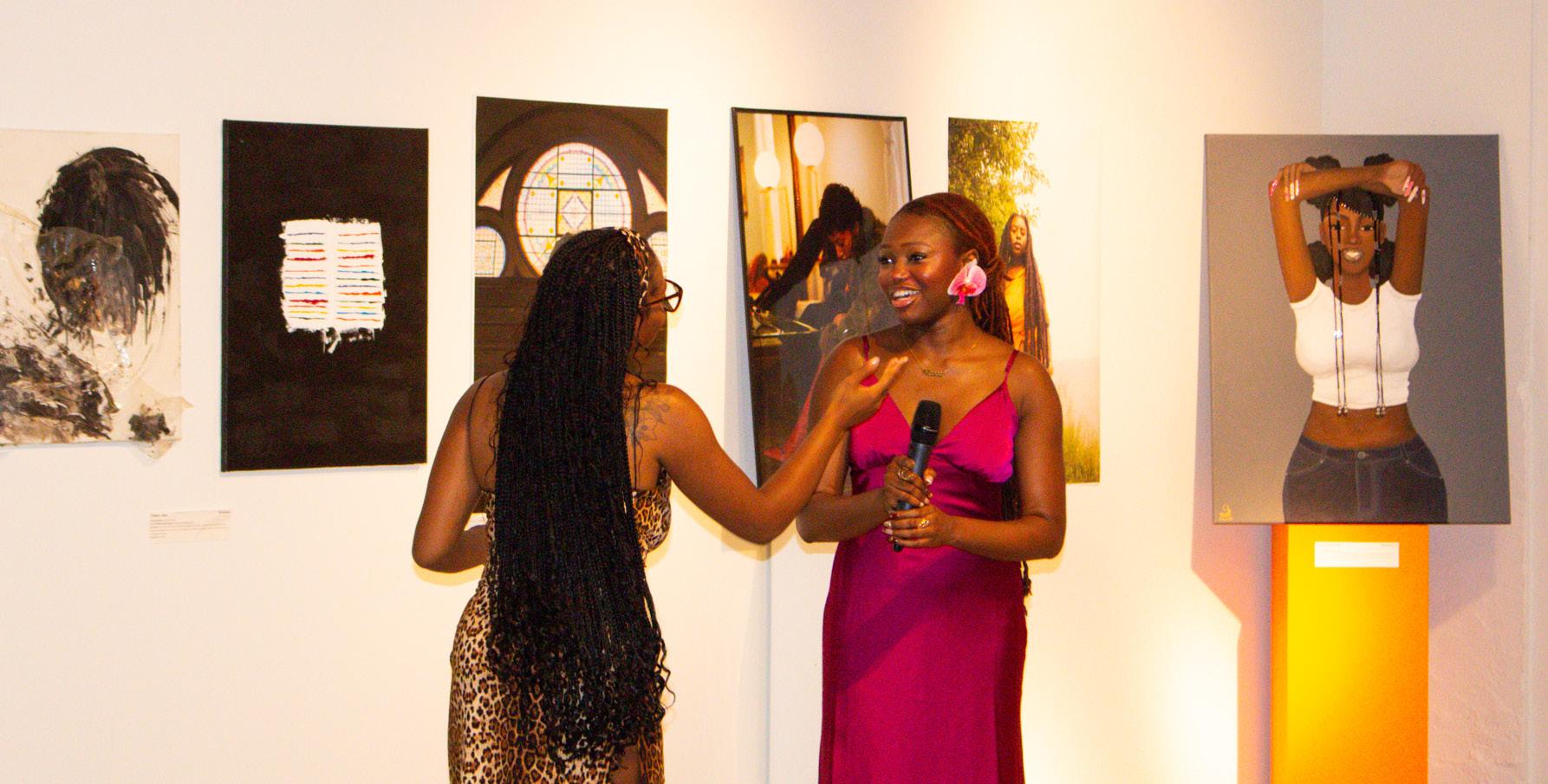
her sight on her goals.”
Cadogan added, “She’s put in a lot of work, lots of tears, lots of late nights…she’s going to do great things.”
In spite of venue changes and models dropping out, Elcena said she persevered and was shocked by the turnout for the event.
“I was kind of nervous at the start of it and it showed me that if I can do this then I can do more,” said Elcena. “I’m very appreciative of all my friends and family that came out.”
Bonair said it’s important to have a plan and to be prepared for it to fall through. She said
setbacks are inevitable but urged everyone to stay resilient. “Try. You never know what could happen. We pulled this off and it was crazy. So yeah, just bet on yourself and don’t give up.”
When reflecting on her time spent as a part of TMU’s fashion program Elcena recalled her favorite professor Caron Phinney who she personally connected to as they were both Black women.
“As a Black designer you do have to work ten times harder than everyone else, I’m not going to sugarcoat that,” said Elcena. “[Phinney] helped further push
me as…a Black designer in the space, especially as a woman.”
With a lineup of all Black visual artists at the exhibit to support the runway show, attendees noted how important it is to not only support local designers and artists but also to support young Black talent.
TMU journalism alumnus and model in the runway show Akosua Yeboah said, “Toronto has so much talent, especially Black talent. I feel like we’re definitely underrepresented in every facet of media.”
“I love the idea of a future where more Black talent is recognized,” she added.
mining it through TikTok…is kind of stupid.”
Rana recalled radio stations used to hold that power. He said just five or 10 years ago, labels leaned on radio networks to boost the success of their songs, which “comes out of that tradition to create some sort of marketable commodity.”
A study for Information Development found that social media has shifted power to audiences, making it harder for labels to control which song becomes popular—and tougher to predict an official “song of the summer.”
Rana said labels now “look for a song that’s trending and becoming viral at a particular moment that they can then frame as that song.”
According to Billboard Music, the top-streamed song this summer was “Ordinary” by Alex Warren. So is that all it takes—being the most listened-to song between June .20 and Sept. 21?
Ayla Baldwin, second-year professional music student at
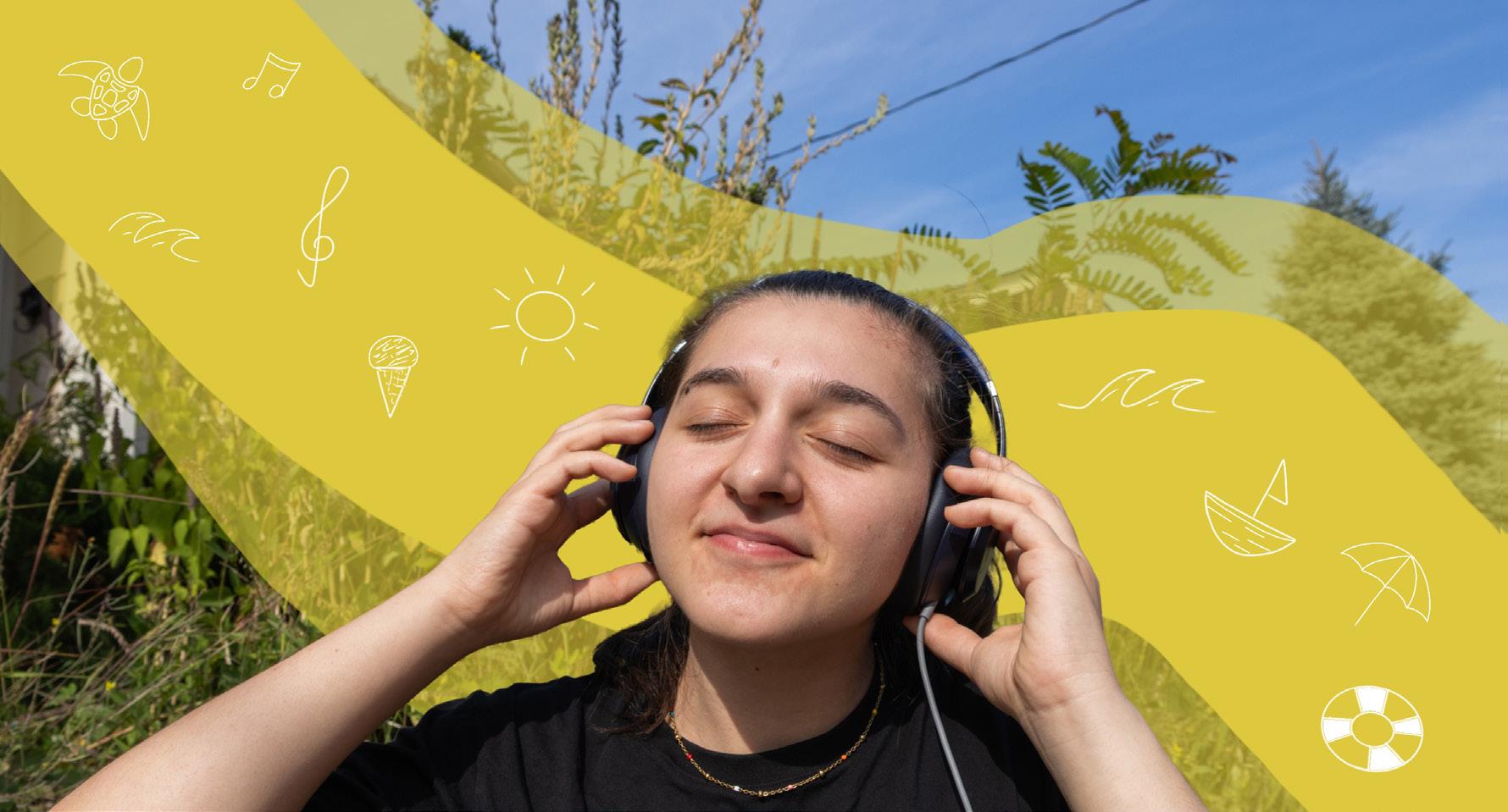
TMU, said Billboard Music’s label holds little value. “People don’t want to be told that this is the song of the summer and that’s why you should be listening to it,” she said.
For her, it’s “a song that you could blast in your car with the windows down.”
Martin also disagreed with Billboard’s pick. She said it “wasn’t even released at the right time to be the song of the summer.”
She added that viral success isn’t a reliable indicator of a song’s value. “The song of the summer could be considered a clip on TikTok of a 20 second song. It just doesn’t make any sense.”
Martin said this has hurt the craft of songwriting. “A lot of the time [people] go on Spotify… and realize that the song isn’t actually that good,” she said. “The artist focused on making that one part viral, which is…not great for artistry right now.”
“I don’t want to listen to 20 seconds of a song that’s good,” she added. “I want to listen to a full song that is well-written and sounds great.”
Baldwin, who worked in a restaurant said, “Benson Boone was definitely the most played artist at my restaurant and by the end of the summer, I knew all the lyrics to at least a few of his songs.”
Yet, Boone didn’t appear in the top 10 on Billboard Music’s songs of the summer chart.
Edison Wilmot, second-year media production student, said “I literally heard more Benson Boone songs than [“Ordinary”].”
He added, “It’s not so much what’s streamed, but what’s being talked about and [has] the most influence on people and society.”
This phenomenon is also unique to the summer season only, said Rana, because “people are off school and they want bright happy songs that get you in a good mood.”
Read more at theeyeopener.com
Long COVID can upend the lives of those who have it—when you're a student, it can be even harder
Words by Rogene Teodoro
Visuals by Ava Whelpley
Disclaimer: A source in this article, Emerson Williams, is a contributor at The Eyeopener. She was not involved in the editing process of this article.
SAFFRON BINDER LEARNED about long COVID the hard way—by getting it. It was January 2022, two years before she’d enroll at Toronto Metropolitan University (TMU) and she’s sick with what she only suspects to be COVID-19. Around the time she thinks she should be getting better, she starts having unexplainable symptoms—respiratory issues, pain in her back, joints, muscles, neck and pretty much everywhere else. She also has fatigue, shortness of breath, postnasal drip and the most worrying to her—chest pain.
"Weeks go by, and alarmingly, her symptoms aren’t going away"
Weeks go by, and alarmingly, her symptoms aren’t going away. It affects her ability to sleep, to work and to live her life as usual. She can’t even walk her dog around her neighbourhood without becoming exhausted. She’s desperate to understand what’s happening to her and her body.
Binder does what anyone might do in this situation and visits her family doctor. She shares her anxieties over the chest pain—aware that long COVID can increase the risk of cardiac issues. However, her doctor refuses to refer her to a specialist—not even for her other symptoms like joint and muscle pain. Binder then urges her doctor to approach the situation with more urgency, but this too gets her nowhere.
She begins to realize if she wants help, she’s going to need to look elsewhere.
LONG COVID—sometimes called post COVID-19 condition—is defined by Health Canada as a condition where the symptoms of COVID-19 “persist for more than 12 weeks after the infection.”
Health Canada lists some of the most common symptoms in adults as fatigue, trouble sleeping, shortness of breath, general pain and discomfort, cognitive problems (such as memory loss or difficulty thinking and concentrating) and a variety of mental health symptoms—including anxiety and depression. These however are only a handful of the over 100 symptoms associated with the condition. One’s symptoms can also vary in severity—some disappearing, reappearing or worsening over time.
Long COVID is not uncommon either. Among Canadians who’ve had a

Binder turns to the internet and compares her symptoms to people who’ve had similar ones. After matching her symptoms with her findings, it all becomes clear to her—she’s dealing with a postviral illness, and she’s now confident enough to give it a name—long COVID.
confirmed or suspected COVID-19 infection, 16.7 per cent develop long-term symptoms. Studies have shown that every infection of COVID-19, regardless of the severity, significantly increases one’s risk of developing a post-COVID-19 condition.

Symptoms can last far longer than 12 weeks too. Among Canadians who developed long-term symptoms, nearly half had them that last a year or longer, according to Health Canada. This can significantly disrupt the lives of those affected.
Long COVID can also be hard to identify. Those affected can show symptoms even if they weren’t formally tested and diagnosed with COVID-19 in the first place. Long COVID can also develop in patients who only had mild to moderate symptoms during their initial infection.
"...what matters most is validating and accommodating those facing the condition"
Dr. Jennifer Hulme, a physician in the Emergency Department (ED) at University Health Network (UHN) has seen this play out in many of her patients.
She says many patients have trouble making the connection between their symptoms and their initial infections.
“They might not even know they had COVID—they just know they had a virus and that they never got better,” she says. “Or, things crop up weeks to months later—and I think that’s really confusing,” she adds.
Hulme doesn’t just treat those with COVID-19 and long COVID—she also experienced it herself.
Her life was completely upended by the condition after she caught it from her kindergarten-aged son in April 2022. She went through months of seemingly-endless symptoms. While her initial infection was moderate, her health took a sharp turn for the worse nearly two weeks after she tested positive—around the time she should have been fully recovered.
Though she’d worked with hundreds of COVID-19 patients and knew anyone who caught the virus had a chance of developing a post-viral illness, she didn't think it’d happen to her.
Her symptoms—including partial hearing loss, pulsatile tinnitus, fatigue, vertigo, brain fog, palpitations and memory loss—forced her to take nearly
a year off work. During this time, she became increasingly interested in the illness and its cases.
Hulme admits that long COVID—and the lack of knowledge around it—worries her a lot. She stresses that there is an urgent need to find treatments for the condition and to mitigate the spread of COVID-19 as a means to prevent it. She also says the misconception that COVID-19 is only as severe as influenza or the common cold is still very prevalent.
Hulme has dedicated much of her time to organizations which research long COVID, she’s now an expert in long COVID treatment. She helped write the Canadian Guidelines for Post COVID-19 Condition. This October, Hulme will be attending the third annual Canadian Symposium on long COVID in St. Johns, Nfld. The symposium’s goal is to bring together medical professionals, researchers and those who've lived with long COVID to discuss the latest on the condition.
Hulme also says as a medical professional, she's been lucky to have access to treatments that likely would not have been available to her otherwise.
She has spent more than 40 sessions in a hyperbaric chamber, a pressurized enclosure which submerges the patient in 100 per cent oxygen, raising the blood oxygen level as a way to promote tissue healing and fight infection. She says this brought back hearing in her deaf ear. Another treatment she’s tried is ganglion blocks—injections of a local anesthetic in the neck to block groups of nerves as a means to diagnose or treat pain.
“My sense is that if I had not done those things, I would not be here—I definitely wouldn’t be working,” she says.
Hulme says that while these treatments worked for her, there isn’t a “magic bullet” that works for all long COVID patients. She says, a lot of the time, what matters most is validating and accommodating those facing the condition—especially those whose lives are more likely to be upended by it, like students.
For students—including those at TMU— long COVID can make the already-stressful university life much harder.
SOMETIME BETWEEN LATE 2021 and early 2022, now-fourth-year journalism student Emerson Williams catches COVID-19 for the first time. Her symptoms are intense.
“I was just like, insanely sick, I couldn’t get up, I was throwing up,” she says. She recovers from the infection and her symptoms subside but they come back even worse when she catches COVID-19 a second, then third time. It’s
after the second infection that she realizes her symptoms aren’t going away. During the third infection, Williams has muscle weakness in her legs and can’t walk for several days. Since then, she’s had ongoing symptoms that disappear and reappear frequently.
In fall 2022, she moved from her hometown of Elmira, Ont. to Toronto to attend TMU. However, she says her condition has held her back from experiencing university-life to the fullest—both academically and socially.
On more than once occasion she had to be carried out of her Pitman Hall dorm on a stretcher by paramedics due to her illness.
Williams also says she feels faculty can do more to support students with chronic illnesses like long COVID.
According to Williams, her friends have been the biggest support during her illness. She recalls one friend, who is a nurse, helping her find new positions to comfortably sleep. Another time, when Williams was studying, a friend helped her through a period when she was coughing up mucus which had accumulated in her lungs. She says friends helped her pick up her prescriptions and supported her in small ways like sitting with her for hours when she felt too weak to move.
BINDER IS NOW IN HER second year of the public health program at TMU—a program she chose to enroll in because of a desire to learn more about disease prevention and mitigation. Before coming to TMU, she studied at the University of Ottawa for environmental studies but dropped out due to a lack of hybrid and online-learning options.
“I didn’t feel safe going to campus at that time,” she says.
The worst of her long COVID symptoms subsided after about two years but her journey to recovery was long and tumultuous.
After giving up on her family doctor, she turned to two separate clinics specializing in long COVID. She says neither of these helped her in a significant way. Binder’s appointments happened over video calls. She says one of the clinics insisted improving her exercise would im-
prove her condition. Binder disagreed, believing what she needed most was rest.
"She feels this is a chance to educate people and protect others from the illness"
The National Library of Medicine says that in some cases, physical exercise has “decreased [the] duration and intensity” of long COVID in most patients affected by it. However, UCLA Health says recent studies show “strenuous exercise often leads to a flare of long COVID symptoms.”
The researchers behind the studies found that although oxygen gained from exercise was "successfully transferred from the lungs and into the bloodstream,” the tissues inside the patients’ bodies are “unable to access and use it.” This is caused by abnormal behavior in the Mitochondria— which uses oxygen to generate what the muscles need for energy.
Hulme says what’s needed for most long COVID patients is rest.
“You need to rest and pace,” she says. “And the only way you can get out of this cycle of boom or bust, is to rest.”
IN LATE 2024, Binder hears that students at the University of Toronto (U of T) are starting a ‘Mask Bloc’—a collective set out to “re-normalize COVID-safer practices at the university,” according to their Instagram. Members of the new group invite students from other postsecondary schools—including OCAD University and TMU—to discuss what the organization will look like. Binder attends the meeting and finds the work they’re doing to be incredibly inspiring, so much so that she and another student decide to bring the idea to TMU.
After suffering from long COVID for such a long time, she feels this is a chance to educate people and protect others from the illness.
In January of this year, they founded Mask Bloc TMU, an “autonomous disability justice collective” with similar goals as its U of T counterpart. They advocate for clean air on campus and provide COVID-prevention resources
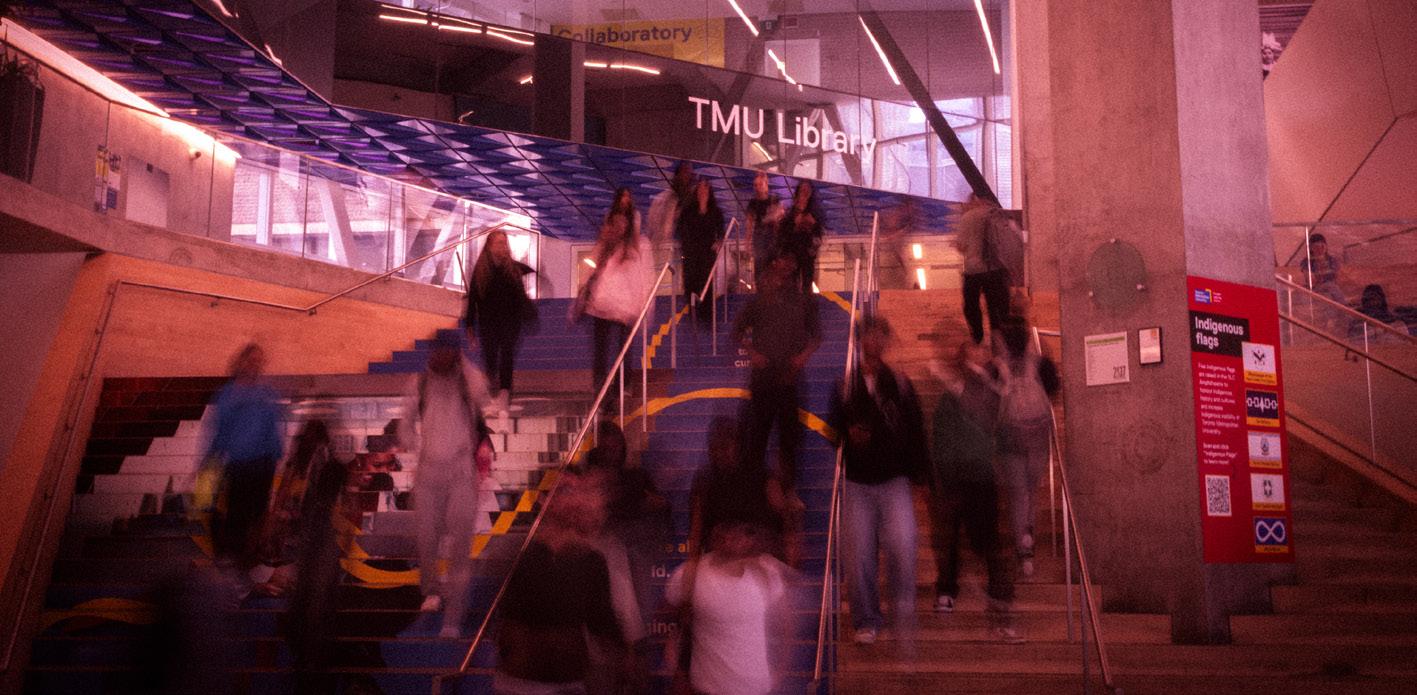
to students, such as free N95 masks and rapid test kits.
Today, Binder and the other members of Mask Bloc TMU spend a lot of time managing the group—tabling on campus and sharing with students the need to mask and test for COVID-19 regularly as a means to protect each other.
“I think a lot of people really don't understand the risks and the stakes and there's a lot of misinformation out there,” she says. “So it's hard to convince people to mask when they're unaware of why you should be masking and the consequences if you don't.”
Binder says one of Mask Bloc TMU’s biggest pursuits is working to ensure the air quality on campus is up to standard.
In a TorontoMet Today article from fall 2021, the university said one of their steps to “ensure adequate ventilation
on the second floor of the Student Campus Centre—and spread awareness of the urgency of COVID-19 prevention.
Mask Bloc TMU has yet to receive student group status—though they are working on it. This means they don’t receive funding from the university. Instead, they are supplied with resources from community organizations like Mask Bloc Toronto and Canadian charity Donate A Mask.
Binder says Mask Bloc TMU has been met with a lot of support from students and community members alike. She says people are “very curious” when approaching them for information at tablings. She adds that the collective has also received support from professors at the university—some from the School

in indoor spaces” is to install MERV 13 filters—air filters made for labs, hospitals and data centres that are meant to keep air clean. They also supplied classrooms with air purifiers, which are to be used to enhance the air quality where necessary. Binder, however, says since their introduction, she’s noticed that many of the air purifiers are either broken, turned off, or professors don’t use them.
"...when public health doesn't protect us, we are able to protect each other"
According to the Government of Canada, Canadians spend approximately 90 per cent of their time indoors. Because of this, indoor air quality can seriously affect health. The U.S. Environmental Protection Agency says the COVID-19 virus spreads “via airborne particles and droplets.” Indoors, especially in small rooms, the airborne particles and droplets can accumulate. This enables those within a room to have contact with the virus even if the infected person has left the room.
Binder says Mask Bloc TMU is in the early stages of their mission. Since their founding, the members of the collective are doing their best to keep their mask stations stocked—their main location is
of Disability Studies include Mask Bloc TMU as a resource in syllabuses.
Binder says the support from the community and other organizations gives her hope.
“I think [this is] a really good show of solidarity and they're kind of proof that when the government doesn't protect us, when public health doesn't protect us, we are able to protect each other,” she says.
“I think it's a great testament to how deeply people care about each other.”
DURING HER LONG ROAD to recovery, Binder turned to painting abstract acrylic art as a means to connect with her community. To Binder, art was a way to “express the pain and frustration and grief” she was feeling during this time.
Binder says she wanted to preserve the memory and emotion of the COVID-19 pandemic through her works. One of her favourite art pieces is Unfinished Painting by Keith Haring. Made during the AIDS epidemic, the painting represents the loss of life to the disease, including the artist’s own.
One of Binder’s paintings is titled Tests—showcasing 61 used test devices she accumulated over time. The piece features two parts, one of which holds 60 negative tests and one positive displayed on a canvas painted blue. The other part is a smaller canvas, painted red, with a single positive test for COVID-19. Binder’s artist statement reads “even if you test negative 59 times, all it takes is one positive to turn your life upside-down.”
By Avari Nwaesei
Downsview Park, home to the Toronto Metropolitan University (TMU) Bold men’s and women’s soccer teams, is being cast aside by none other than TMU itself.
When it comes to TMU’s investment in its varsity teams, students are getting the sense that soccer is not as much of a priority as it should be.
“They don’t really promote soccer as much as they do the other sports,” said second-year sport media student Jayden Prasad.
Prasad isn’t the only one to have this view. Fellow secondyear sport media student Aidan Loftus said that TMU’s interest in soccer is “kind of lacking.” The observations made by the two are not without reason. “I haven’t seen many banners around the school besides in the Mattamy Athletic Centre,” Loftus said.
Not only is there a shortage of soccer media presence on campus, but for students there appears to be a notable difference in how promotional material for varsity sports is pushed in comparison to the various sports clubs at TMU.
“I think soccer is kind of grouped together with a lot of other sports at TMU that aren’t promoted as
much like baseball and…rowing and cross country and all that stuff,” said Prasad.
Students are not the only ones to take note of how TMU might be putting their soccer teams on the sidelines. Fifth-year men’s soccer midfielder Justin Santos said the promotional work he’s done for soccer so far is “nowhere near” as much as the other teams.
“I feel like obviously they still do pay attention to soccer but I feel like just because it’s on campus, the volleyball, basketball and hockey teams definitely get the most attention, which doesn’t always feel greatest,” said Santos.
Fewer chances given to the soccer teams to have a larger presence in TMU athletics goes hand in hand with what game turnouts look like.
“They don’t really promote soccer as much as they do the other sports”
As far as crowd encouragement goes, not much of it can be heard at the Downsview Park fields.
“When it comes to playoffs, I think we get more fans than usual, obviously but definitely not as many fans as the teams that play downtown,” said Santos.
By Eunice Soriano
Amidst the roaring cheers and cries of a Toronto Metropolitan University (TMU) Bold sports game, there lay students who are also grappling with the struggles of meeting new people, learning a new language and adjusting to the hustle and bustle of Toronto.
With eight varsity teams, 12 varsity clubs and 10 competitive clubs, many international students hope that the TMU Bold community will be a stepping stone in immersing themselves in the city’s culture.
Hailing from Mumbai, India, second-year psychology student Abhineeta Sharma rushed into the Mattamy Athletic Centre (MAC) with excitement and was met with the blaring sirens of the packed hockey rink for TMU’s 2024 Homecoming game—her first time watching hockey.
While analyzing the game, she was quickly taken aback when she saw players engaging in brawls and getting smashed into the boards.
Sharma said that in Indian sports culture, student-athletes “go soft-

Crowd presence is an essential part of the game and something that Santos said is a “massive thing” when it comes to how the team ultimately plays.
“They do say ‘home advantage’ and it is an actual thing. Just that noise from the crowd, encouraging us and obviously trying to shake up the opponent, definitely plays a factor in the game,” said Santos. “And I don’t think we have that at Downsview.”
The desire to have a crowd is no different for the women’s soccer team. First-year forward Taylor Fazzari is also appreciative of fans who come out to watch her team’s games.
“I think having that crowd is definitely a lot more motivating. It definitely brings up the spirits pretty high for myself and my team,” said Fazzari.
While filling up seats does a superior job in motivating the team, the frequent absence of TMU’s
mascot, Frankie B. Bold, is a dent to the school spirit at games that can’t be patched over. Frankie’s most recent appearance was at the women’s soccer Think Pink game on Oct. 4—which had a table that allowed attendees to donate money for breast cancer research—but more often than not, his attendance is a rare occurrence.
“I don’t think [Frankie has] ever been in a soccer game that we had,” said Santos. “I know he’s come to basketball, hockey and volleyball games and given out TMU Bold towels or t-shirts. I don’t think we’ve ever had a giveaway at Downsview.”
Without the mascot showing up for these varsity teams, it begs the question of how TMU’s soccer culture can possibly grow. The sport media students have an inkling of what might bring in a crowd.
“Giveaways to the first hundred students or something would be really cool,” said Prasad. “A lot more promotional content, pro-
motional videos. That would certainly help initiatives.”
Regarding the soccer teams, second-year sport media student Alex Gisonni wants TMU to “put it out there more” in order to get a bigger community around the sport. “Relay the information more so that it attracts people,” Gisonni said.
“I don’t think [Frankie has] ever been in a soccer game that we had”
The call for more team visibility and consistent community engagement is a long time coming.
“No matter what, if we’re already in a high or if we’re in a low, it helps us to push harder,” said Fazzari. “And in the end, for that game, we got the biggest result that we could possibly ask for.”
The TMU Bold soccer teams continue to give their all on the field— but the question remains, when will the university match their energy?
er” in the games because playing roughly can reflect poorly on an athlete’s reputation.
“If you see TMU Bold ice hockey matches, it’s a bit of pushing and attacking…but when you’re playing with a university back in India, that can affect you very badly,” said Sharma. “When you get violent, it is seen like you do not respect the sport, or you do not respect the person in front of you.”
Sharma highlights that access to facilities and media coverage is another key difference between collegiate athletics in Toronto and Mumbai.
“[Playing sports at the professional level] is not usually seen as a career…it’s too underpaid. There’s not an audience for it and facilities,” said Sharma.
Throughout the years, some players have soared to new heights while repping the blue and gold, propelling themselves into professional careers beyond the Bold.
Whereas many fans draw inspiration from these star athletes, other students also become engrossed in the process that brings the highspeed action to larger platforms.

Fourth-year sport media student
Jazmin Gaura has embraced various roles within the TMU community, from a cheering fan on the sidelines to a camera operator on the TMU Bold Broadcast Group—a team of aspiring media creators who work diligently to broadcast live games on OUA.TV.
While observing the action, Gaura has noticed the lack of fan attendance, which is a stark contrast to the lively energy surrounding the American university sports scene in her home state of Connecticut.
“At NCAA schools, everybody’s going to games a lot. And I know
that’s something that the Bold has [been] struggling with—getting more community members to go, which obviously I understand, it is a commuter school,” said Gaura. Growing up, Gaura would watch hockey alongside her dad and brother. Whenever that nostalgia and longing would settle in her, she would attend the TMU hockey games—a tie that forged her family together even miles apart.
“First year was a bit tough to connect with people…so being able to go to hockey games, even just on days where I was feeling sad or lonely or homesick, was re-
ally, really special for me, and it got me through a lot,” Gaura said. Other international students also seek out the Bold games as a way to make new friends outside of the rigorous hours within the classroom.
Fourth-year business management student Jessie Tran-Nguyen moved to Toronto from Da Nang, Vietnam in 2019, and brought her passion for sports with her. Over the past four years, she has become an avid Bold fan, watching volleyball, hockey and basketball games regularly.
“Risk it for the
why TMU entrepreneurs aren’t playing it safe in 2025
Despite record-low funding, startups are staying bold and using campus resources to push their ventures forward

By Aditi Roy
Raising capital in 2025 has been more challenging than ever, given the current economic state of the country. According to the Canadian Venture Capital and Private Equity Association’s (CVCA) report, Canadian venture capital investments have fallen 26 per cent from 2024, hitting their lowest level since the pandemic.
At Toronto Metropolitan University (TMU), student entrepreneurs are facing a high-risk climate, learning to launch and fund their ideas in an era of tighter capital and higher stakes.
The CVCA reports that, in the first half of 2025, only $297 million went into pre-seed and seed stages, which are initial investments for startup launch, across 133 deals in the first half of 2025. The report shows a 16 per cent drop in total funding and a 28 per cent decline in the number of deals compared to the same period in 2024, illustrating the steady decline that has been unfolding since the post-pandemic investment boom.
Matthew Robertson, director of venture growth at MaRS Discovery District—North America’s largest urban innovation hub—acknowledged the heavy burden facing new founders, noting that investors now expect clearer product-market fit and stronger early traction.
“It’s a very challenging time for founders to raise capital right now, both at the pre-seed and seed
stages, relative to pre-pandemic years,” he said.
Shahkir Alkozai, co-founder of VolTrack—a startup focused on car safety and theft prevention— and a first-year master’s student in engineering, sees the shift firsthand. “In 2020 it was fear of missing out because everybody was raising. Now it’s fear of starting, because you might fail,” he said.
Robertson emphasizes that cycles of uncertainty are normal and shouldn’t dissuade young founders from building something new.
“This is still one of the most exciting times in history to start a company,” he added.
The rise of artificial intelligence (AI) and emerging technologies in 2025 has enabled students to explore the potential of entrepreneurship without the need for large teams and excessive funding.
The use of AI in Canadian businesses has doubled from 6.1 per cent to 12.2 per cent in 2025, according to Statistics Canada.
“In 2020 it was fear of missing out because everybody was raising”
Robertson remains optimistic about the possibilities AI and new technologies that will open up for founders. “People will say you can build a product over the weekend, and the real challenge is deploying it in the market and getting traction,” he said.
Not everyone shares this optimism. Some see significant drawbacks in an AI-reliant society. Fourth-year marketing management student Manan Jain shares his skepticism about the integration of AI in businesses. “Because of COVID, everything moved digital…Now that all the research and branding feels AI-driven, nothing feels authentic anymore,” Jain said.
Isha Sidhu, president of the TMU Entrepreneurship Association and a fourth-year business management student majoring in human resources, notes that students often struggle to navigate funding options and figure out where to start. “There’s so much available that it can feel overwhelming,” she said. “It’s not always clear what step comes first or who to go to.”
Alkozai secured $15,000 from DMZ’s Basecamp during these turbulent times and recognizes how intimidating and cutthroat the current landscape is for new founders. “We’re never going back to 2020 levels with zero interest rates,” he said. “Now only the strongest ideas and teams will survive.”
Jamelia Allen, the DMZ Skills Academy programs specialist, sees firsthand how difficult the market has become for this year’s cohort. “There have been more funding barriers, so investors might see a student-led startup as really high risk due to the limited experience,” she said. “And as they’re scaling
back on the funds they’re giving out, that also adds to the issue these students are facing,” she added.
Allen notes that the struggle often continues even after students gain early traction. “We’ve seen some of the student ventures lose momentum once they no longer have access to campus resources, whether it’s accelerators, labs or mentorship,” she said.
“There are nights you work on a marketing plan until 3 a.m.; it’s not glamorous.”
Nodalli co-founders and TMU graduates Jason Ramsay and Joshua Daniel—whose startup aids students in networking and building professional connections—describe the exhausting nature of entrepreneurship. “There are nights you work on a marketing plan until 3 a.m.; it’s not glamorous but it’s the truth,” Daniel said.
Ramsay echoes the feeling of relentlessness. “One of the hardest parts is you’re always on—always thinking about fundraising, product, operations even at 4 a.m.,” he said. “There isn’t balance, but when you’re passionate, it doesn’t feel like work,” he added. The constant late nights—and their running jokes about being sponsored by Red Bull—say otherwise. Despite the strain, both credit TMU’s ecosystem for helping them stay grounded and move forward in their journey. Having secured
$20,000 through DMZ’s Basecamp program and other unnamed funding opportunities, they say support networks have been critical.
For some aspiring entrepreneurs, the barriers feel more daunting. Despite his ambitious nature, Jain describes the stress of starting in 2025. “With the economy the way it is, I think you need to be more careful,” he said. Jain recognizes that many students who dream of entrepreneurship are also torn between the prospects of security through a fulltime job and the volatile nature of founding a startup.
Jain remains adamant about starting his venture in the final year of his undergraduate degree, even though the possibility of failure looms large. “I feel there’s an insane amount of competition—everyone is racing to grow fast, and the market is volatile,” he said. Jain admits he’s cautious about the prospect of funding, wary of diluting his company’s shares significantly before even launching his idea.
Robertson notes the grim reality that few ventures make it past the initial stages. “You have to show more traction, better productmarket fit and a clear path to revenue,” he said. “There are far fewer examples today of startups getting funding before they’ve proven anything,” he added.
Still, for Alkozai, persistence remains the defining trait, even in a volatile and uncertain economy. Or, as he put it, “Sometimes you have to risk it for the biscuit.”
By Rustin Peace
Disclaimer: Like a dead man enjoying his eternal slumber, this story fully lies.
Kevin the Pigeon
Kevin the Pigeon, age 3, tragically fell from great heights this Tuesday after mistaking a freshly cleaned window of the Student Campus Centre for open sky. Known for always eating whatever food was left on the ground and his uncanny ability to always be in your way on Gould Street, Kevin will be remembered for his fuckass eyes, weird little bird feet and complete disregard for personal space. Services will be held in Kerr Quad this Friday, weather permitting.
The will to attend 8 a.m. classes
The will to attend 8 a.m. classes passed away peacefully in dorm rooms across campus this semester. Born during freshman orientation, it enjoyed a short but spirited life of optimism and punctuality before succumbing to the sweet lure of snooze buttons. In lieu of flowers, donations may be made in the form of Uber Eats gift cards.
The concept of time during reading week
The concept of time itself disintegrated shortly after reading week began, when “Monday” became “Kind of Wednesday” and “Today” was just “The Day Before That Thing.” Funeral rites were delayed due to no one knowing what day it was. What day is it?
The Fun & Satire editor at The Eyeopener
Wait if this guy’s dead…then who’s making this page layout?
Your laptop battery
Your laptop battery, which died during an in-class presentation despite being “plugged in, not charging” for over 45 minutes, will be remembered for sounding like an F-16 every time you wanted to have more than one tab open. A vigil will be held near the one working outlet in the Victoria Building.
That guy in your group project
That guy in your group project, last seen during the initial group making process proclaiming he would “make all the slides once the information has been collected,” has been declared deceased. No source has confirmed this fact though that has to be the only option that can explain his lack of contributions towards the project. There will be no service, but his name will appear on the final submission...somehow.
The New York Yankees
The New York Yankees, a major league baseball team since 1903, have been murdered by the Toronto Blue Jays. GO JAYS GO!
By Dylan Marks
Disclaimer: Though the SCC fire alarm did go off a few too many times the other day, the rest of this story is full on fiery bullshit.
The fire alarm was pulled twice inside the Student Campus Centre (SCC) building at Toronto Metropolitan University (TMU) last Monday resulting in disruptions for the one person on the couches that was talking at a reasonable volume.
Toronto Fire Services (TFS) have announced they believe the two alarms were caused by “delicious activations” as the influx of people outside resulted in big business for the Gould Street shawarma truck.
“I’d cause a hundred fires for these goddamn french fries”
“We have no idea who pulled this thing but we’re actively searching,” said TFS officer Ed Stinguish downing a chicken platter with fries. “Tell you what though, I’d cause a hundred fires for these goddamn french fries and that’s on the record.”
Though Stinguish was unsure of who caused this mixup, many believe it was the work of the Shawarma truck man himself: Phil Awfel.
“To quote the late and great Shaggy, ‘it wasn’t me,’” said Awfel. “Am I upset that the fire alarm was pulled? Yes, I can’t imagine how scared those students must have been. Am I upset that the fire alarm was pulled monetarily? Nah, let Oakham burn.”
While Awfel denies any involvement in the “chicken on the rocky” situation, students on scene claim the scent of hot garlic and wetly dense meat was unmistakable on the alarms that were pulled.
“To quote the late and great Shaggy, it wasn’t me”
“Honestly, I thought it was a drill but then I smelled the grill and I ordered extra dill, but still it was definitely Phil,” said third-year psychology student Jill Mills.
“I’m pretty sure the art on the front of the truck is AI generated too, I mean when will it end,” said that arts student in your class you hate.
“We were in the middle of the student union’s general meeting and those alarms put a stop to it…which sucksss so freaking bad, God I’m sooo angry about
it,” said a member of the Toronto Metropolitan Students’ Union.
TFS has announced the investigation is ongoing though they believe no suspect will be found because everybody is busy deciding between beef on the rocks and the chicken crazy wrap.
“I guess some people just can’t handle the heat”
As for Officer Stinguish, he was last seen setting up a lawn chair outside the shawarma truck “just in case another emergency happens.”
“You can never be too careful when it comes to watching for fires and stuff,” said Stinguish once again at the truck’s window. “And I’ll do extra pickles and a grape crush,” he added.
Awfel currently maintains his innocence as well as a full grill and those four weird topping containers that you should not eat from.
“Did I pull the fire alarm? No,” said Awfel. “But I guess some people just can’t handle the heat.”

Written and illustrated by Myrtle Manicad
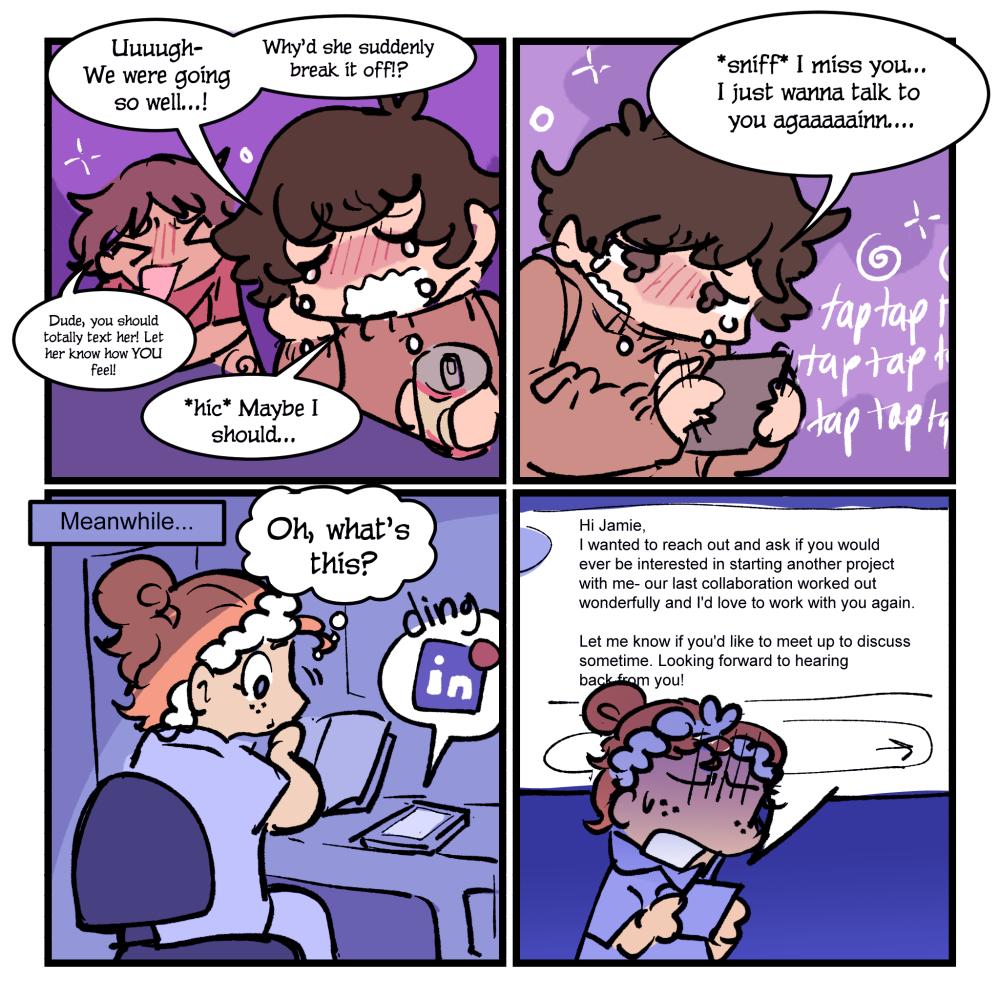



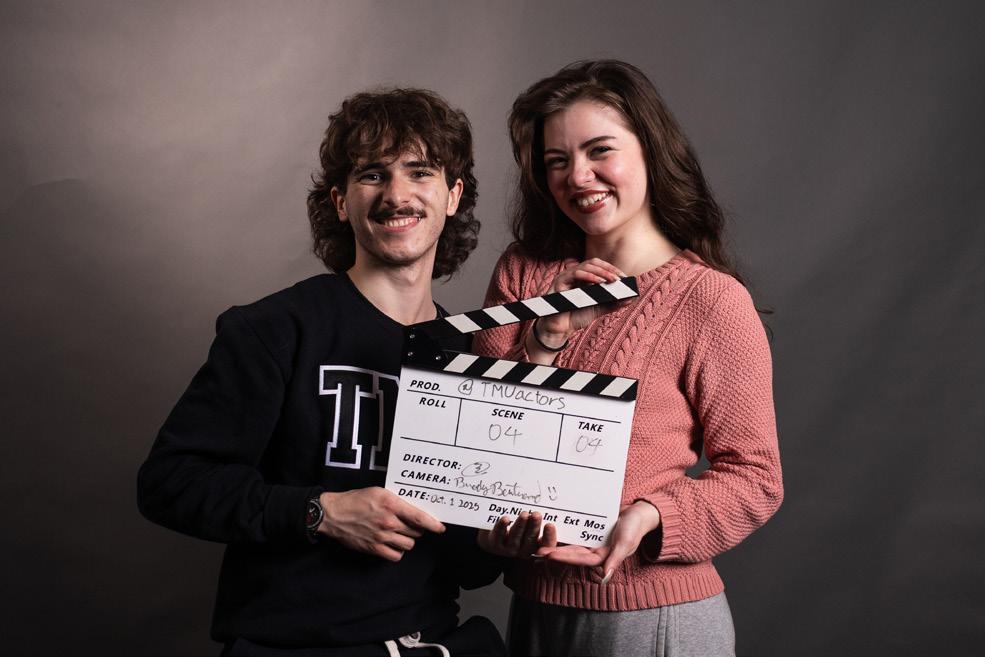
Performance acting students Brady Bertrand and Bo
launched TMU Actors in September as a space for actors and filmmakers to connect at TMU.


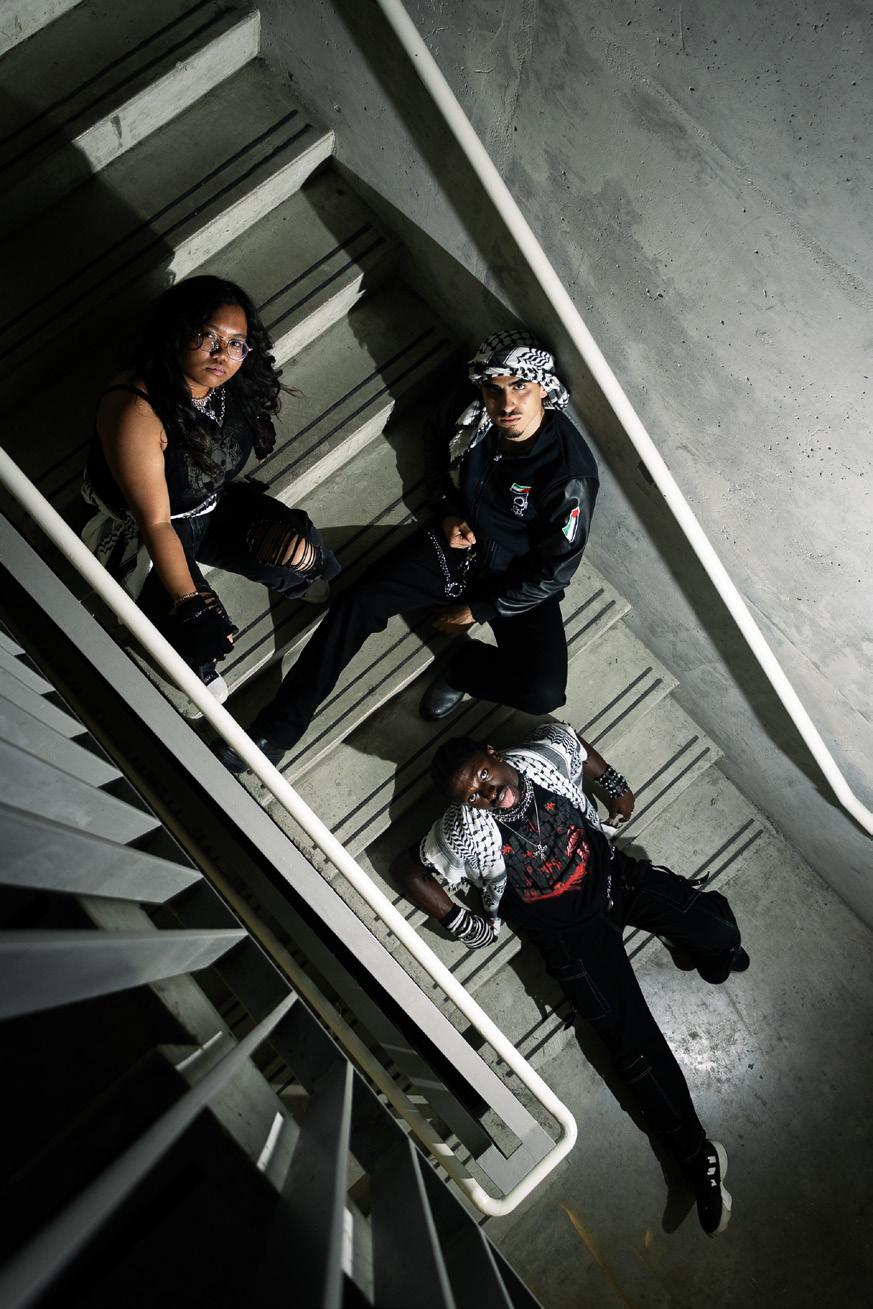

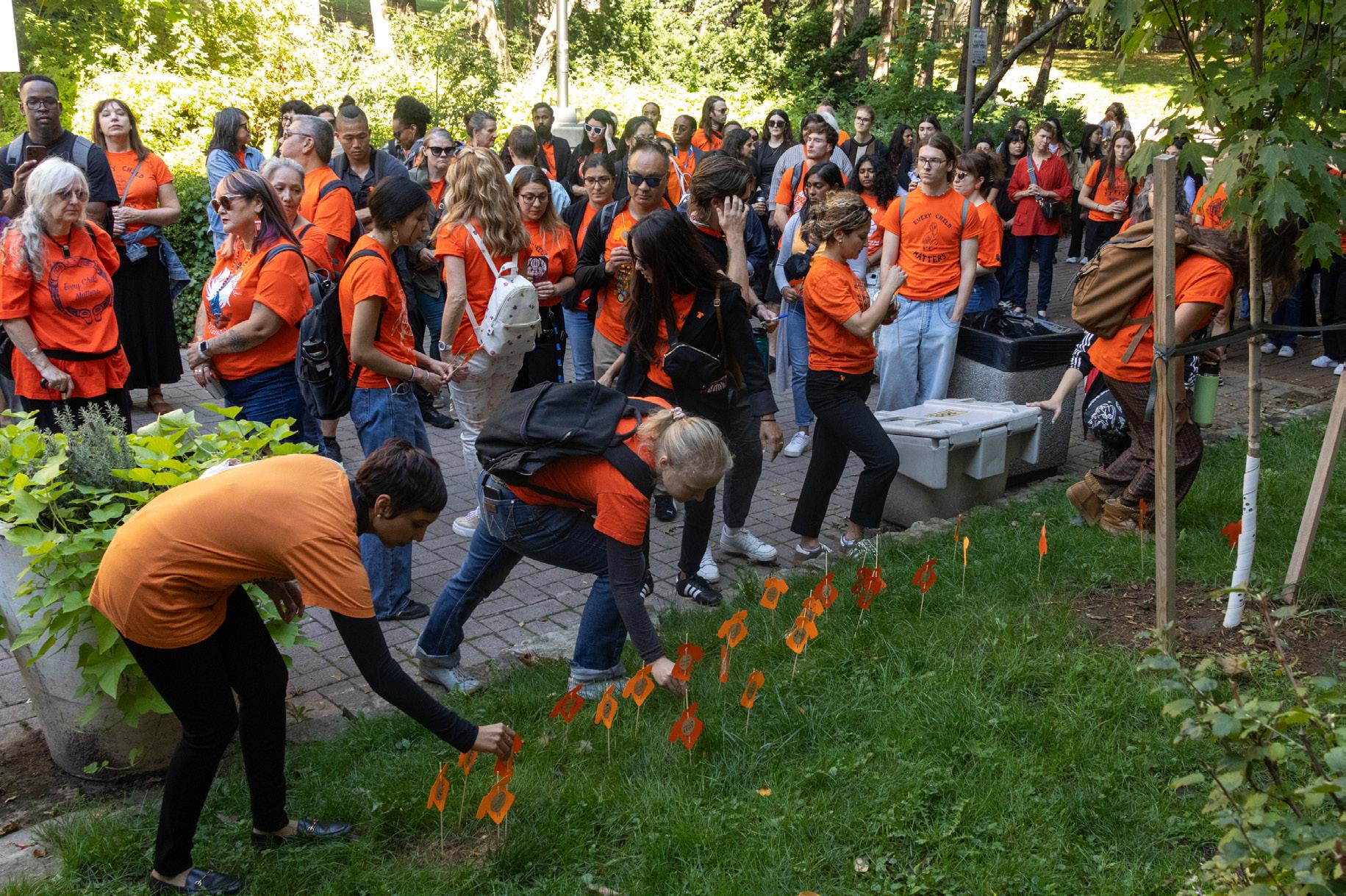
1. A station on Line 1. This is the station where TMU is located, and many students commute to this station via TTC.
2. A piece of paper, also known as a certificate, which shows proof of your academic achievements.
3. A public space that contains books to check out. It is also a good place to study.
5. The universal name for all the sports teams here at TMU.
9. Formally known as Ryerson University, the acronym for this university.
4. TMU’s mascot. The falcon wears blue and yellow.
6. TMU is located in this city.
7. The first home game of the season.
8. A lesson by your professor.



By Jocelyn Reycraft
The Eyeopener is giving away two $50 gift cards to Jack Astor’s Find the giveaway rules through the link in our Instagram bio.

Cheng
Sudoku Hard
Hint: books
Answer: reading
Hint: Thanksgiving
Answer: turkey
Source: sudokutodo.com
How to play
Each column and row must contain every number from one to nine without repetition. Each box must also have numbers one to nine with no repetition. Have fun and good luck!
Hint: guidelines
Answer: syllabus
1. Complete the crossword! Only 100 per cent accurate puzzles will be accepted.
2. Complete the Google Form via the QR code below and add a photo of your completed crossword or visit The Eye office (SCC 207) with the completed puzzle.
3. Await an email! The form will close end-of-day on Oct. 20 and winners will be contacted shortly afterwards and asked to come into our office for photos!
SUBMIT COMPLETED PUZZLE HERE
